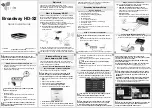
ATR833A-II / P/N 833-II (Axxx)-(Axxx)
Operation and Installation
Doc.-No. 01.143A.010.71e / Revision 1.00
44
4.8.2 Installation Recommendation
Take note of the antenna manufac
turer’s instructions.
The metallic contact between airplane surface and antenna-GND
must be very good. On non-metallic airplanes a metal foil (min. 80 cm
x 80 cm) shall be used as electrical counterweight on the inside of the
belly.
To avoid a mutual interference of the radios, the antenna isolation
between a voice transmission and a navigation antenna as well as
between double COM antennas should be as large as possible. A
distance of 2 meters usually is sufficient.
Assemble the antenna in vertical position so on or under the belly that
it is as far distant as possible from all protruding parts (propeller,
chassis, vertical stabilizer)
For glider installation the internal antenna installed by the
manufacturer should be used.
The SWR shall not exceed 3:1.
4.9 Microphone / Intercom settings
The settings of MIC and VOX values are essential for Intercom. The
respective
configuration
options are
described
in
chapter
(VOX=threshold level) and chapter 3.6 (MIC input sensitivity).
If the VOX automatism is deactivated with VOX=OFF intercom is
activated using the intercom switch (not PTT), which connects PIN 7
(intercom) of the equipment connector to GND.
For operation with VOX activated PIN 7 has to be connected to GND
permanently.
Transmission merely operates when PTT is pressed.
The suppression of background noise is only possible using differential
microphones, as they are usual with modern headsets. Normal electret
microphones are not suitable.
The HF antenna wire must not be included in any other cable
sets, for example power supply or microphone. It must also
not be placed together with other antenna wires, for example
NAV or Transponder.











































